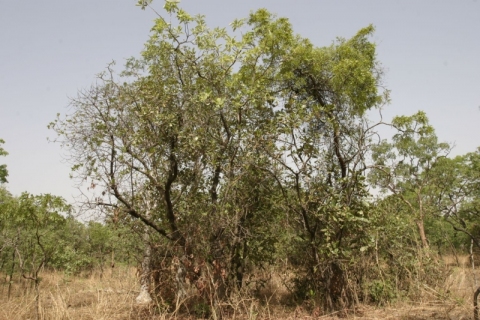Uapaca togoensis
Pax
Phyllanthaceae
Uapaca chevalieri Beille
Uapaca guignardii A.Chec. ex Beille
Uapaca guineensis sudanica (Beille) Hutch.
Uapaca perrotii Beille
Uapaca somon Aubrév. & Leandri
Common Name:
General Information
Uapaca togoensis is an evergreen tree that usually grows up to 20 metres tall, though specimens to 30 metres have been recorded. The bole is around 20cm in diameter, usually with stilt roots, though these are sometimes absent when the tree grows in savannah[
965- Title
- Uapaca (Phyllanthaceae) in the Guineo-Congolian forest region: a synoptic revision
- Publication
- Plant Ecology and Evolution 146 (1) 75 - 94
- Author
- Breteler F. J.
- Website
- http://dx.doi.org/10.5091/plecevo.2013.770
- Publisher
- Royal Botanical Society of Belgium
- Year
- 2013
- ISBN
- 2032-3913
- Description
- A revision of the west African members of the genus Uapaca
].
The tree is harvested from the wild mainly for local use, probably as a food and also as a source of wood.
Known Hazards
None known
Botanical References
965- Title
- Uapaca (Phyllanthaceae) in the Guineo-Congolian forest region: a synoptic revision
- Publication
- Plant Ecology and Evolution 146 (1) 75 - 94
- Author
- Breteler F. J.
- Website
- http://dx.doi.org/10.5091/plecevo.2013.770
- Publisher
- Royal Botanical Society of Belgium
- Year
- 2013
- ISBN
- 2032-3913
- Description
- A revision of the west African members of the genus Uapaca
Range
Tropical Africa - Senegal to southern Chad and Central African Republic, south through Gabon to DR Congo and northern Angola.
Habitat
Mostly in fringing forest and savannah woodland at elevations up to 1,400 metres[
965- Title
- Uapaca (Phyllanthaceae) in the Guineo-Congolian forest region: a synoptic revision
- Publication
- Plant Ecology and Evolution 146 (1) 75 - 94
- Author
- Breteler F. J.
- Website
- http://dx.doi.org/10.5091/plecevo.2013.770
- Publisher
- Royal Botanical Society of Belgium
- Year
- 2013
- ISBN
- 2032-3913
- Description
- A revision of the west African members of the genus Uapaca
].
Properties
| Edibility Rating |      |
| Other Uses Rating |      |
| Habit | Evergreen Tree |
| Height | 18.00 m |
| Self-fertile | No |
| Cultivation Status | Wild |
Cultivation Details
A dioecious species, both male and female forms need to be grown if fruit and seed are required[
965- Title
- Uapaca (Phyllanthaceae) in the Guineo-Congolian forest region: a synoptic revision
- Publication
- Plant Ecology and Evolution 146 (1) 75 - 94
- Author
- Breteler F. J.
- Website
- http://dx.doi.org/10.5091/plecevo.2013.770
- Publisher
- Royal Botanical Society of Belgium
- Year
- 2013
- ISBN
- 2032-3913
- Description
- A revision of the west African members of the genus Uapaca
].
Edible Uses
We do not have specific information for this species, but the fruits of many members of this genus are edible, generally sweet and juicy[
965- Title
- Uapaca (Phyllanthaceae) in the Guineo-Congolian forest region: a synoptic revision
- Publication
- Plant Ecology and Evolution 146 (1) 75 - 94
- Author
- Breteler F. J.
- Website
- http://dx.doi.org/10.5091/plecevo.2013.770
- Publisher
- Royal Botanical Society of Belgium
- Year
- 2013
- ISBN
- 2032-3913
- Description
- A revision of the west African members of the genus Uapaca
]. The more or less ellipsoid fruit is around 25mm in diameter and 20mm long[
965- Title
- Uapaca (Phyllanthaceae) in the Guineo-Congolian forest region: a synoptic revision
- Publication
- Plant Ecology and Evolution 146 (1) 75 - 94
- Author
- Breteler F. J.
- Website
- http://dx.doi.org/10.5091/plecevo.2013.770
- Publisher
- Royal Botanical Society of Belgium
- Year
- 2013
- ISBN
- 2032-3913
- Description
- A revision of the west African members of the genus Uapaca
].
Medicinal
None known
Other Uses
We do not have a specific description for the wood of this species. However, a general description for the wood of the West African, stilt-rooted members of this genus is as follows:-
The heartwood is a pale red, red-brown, or chocolate-brown; it is usually not clearly demarcated from the paler sapwood. The texture is mostly medium to coarse; the grain generally straight; there is little lustre. The heartwood ranges from moderately durable to highly so, and is moderately resistant to termite attack. Generally care is required in seasoning, best results are obtained if quartersawn, logs should be converted soon after extraction to minimize shake
and checking. The wood saws with some difficulty due to a high silica content, it generally finishes well and glues satisfactorily. It is used for purposes such as light construction, boatbuilding, flooring[
316- Title
- Tropical Timbers of the World. Ag. Handbook No. 607.
- Publication
-
- Author
- Chudnoff. Martin.
- Publisher
- USDA Forest Service. Wisconsin.
- Year
- 1984
- ISBN
-
- Description
- Terse details on the properties of the wood of almost 400 species of trees from the Tropics.
].
A good fuel and charcoal wood[
316- Title
- Tropical Timbers of the World. Ag. Handbook No. 607.
- Publication
-
- Author
- Chudnoff. Martin.
- Publisher
- USDA Forest Service. Wisconsin.
- Year
- 1984
- ISBN
-
- Description
- Terse details on the properties of the wood of almost 400 species of trees from the Tropics.
].
Propagation
Seed -
If you have any useful information about this plant, please leave a comment. Comments have to be approved before they are shown here.

 Useful Tropical Plants Database 2014 by
Ken Fern,
web interface by
Ajna Fern
with help from
Richard Morris.
Useful Tropical Plants Database 2014 by
Ken Fern,
web interface by
Ajna Fern
with help from
Richard Morris.